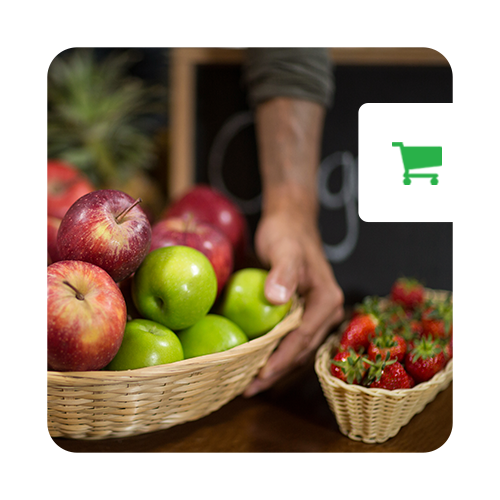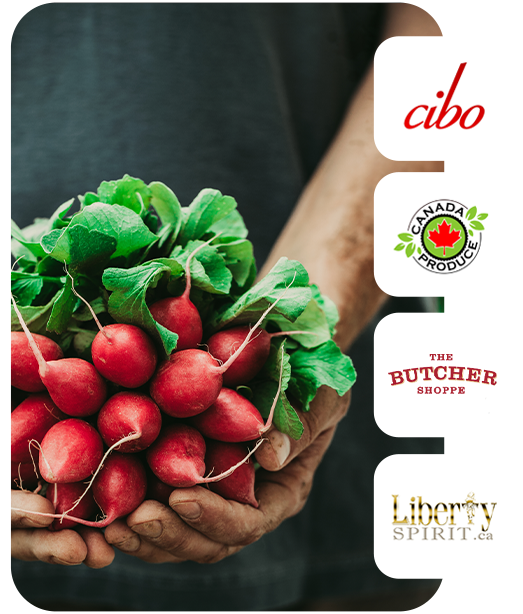Convenient online ordering of curated grocery offerings delivered safely to your door.
Our new delivery platform will offer exclusive quality products, previously only available to restaurants, directly to your home with the added convenience of online ordering, no line-ups and speedy, contactless door to door delivery.
FOR DELIVERY AREAS PLEASE
CLICK HERE

Have a meal in mind? Or getting groceries for the week? Login to our website, select your favorite items and submit your order. We operate 7 days a week with a team member available 24 hours a day. You can reach us through phone, email, or through our customer portal on our website.

Our grocery experts will carefully hand select your fresh fruits and vegetables, vacuum pack each meat item, combine your pantry items along with your list of wine and spirit selection for worry-free delivery to your doorstep. It’s quick, convenient, and we guarantee 100% freshness.

Our fleet of refrigerated trucks will ensure that even the most particular delivery requirements are met with ease. Select your delivery date and experience the convenience of online ordering with fast, efficient and safe delivery direct to your door.

Freshness starts with our buying department and their attention to detail. Let them be your eyes, hands and nose while selecting your produce. We always keep your needs in mind when procuring produce. We believe freshness cannot be delayed.
Use our menu to place an order online. Fast and fresh food.
Blueberries grow on low creeping shrubs or tall erect bushes, depending upon variety. The small round berries can range in size from 5-16 millimeters in diameter. They first appear green, but ripen into a deep shade of dusty blue. The soft, hazy white coating that develops on the skins' surface, which is known as the bloom, is a natural waterproofing which helps protect the berries from the sun and other natural elements. Blueberries have a sweet and woodsy flavor with an acidity that can vary depending upon growing conditions. Long sunny days and warm temperatures develop a higher sugar content, while cooler temperatures and shorter days with limited sunlight increase acidity. After harvest some plants lose their leaves while other varieties retain their foliage year-round, becoming a colorful mix bronze, red and purple in the autumn.
Blueberries are available year-round with a peak season in the summer.
Blackberries are characterized by their coloring, their unique composition and their flavor. Like raspberries, Blackberries are not technically a berry, but rather an aggregate fruit of individual drupes held together by very fine, nearly invisible hairs. Blackberries do not have a hollow center, instead they have a solid, edible core. When ripe, Blackberries have a deep inky sheen with purple highlights. They are succulent, soft, and juicy. Their flavor is sweet, slightly tart, with earthy undertones.
Blackberries are available year-round with a peak season in summer.
The sweet-tart flavor and earthy quality of Blackberries allows them to be used in both sweet and savory applications. The moderately high acidity of Blackberries cuts through the rich flavors of creamy and aged cheeses, or rich fatty meats. Blackberries can be added to ice creams, jams and baked goods. Blackberries also pair well with nuts, aged balsamic vinegar, salad greens, figs, and leafy herbs.
Raspberries are an aggregate fruit of individual drupelets that are held together by very fine, nearly invisible hairs. They have a hollow core and are conical with an overall rounded shape. The hollow core is created when the Raspberry is separated from its growing receptacle. Their flavor can range from sweet-tart to low acid and jam-like depending on growing region and variety.
Raspberries are available year-round, with peak season in the summer.
Raspberries are most often utilized in sweet applications, such as jams, jellies, desserts and other baked goods. Their tart and earthy flavor also works well in salads featuring blue cheese and spicy greens as well as other savory recipes. Combine the berries with ginger, sesame and a touch of soy for a glaze over salmon, duck or chicken. Barbecue sauces, marinades and homemade ketchup all benefit from a touch of Raspberry. Other complementary pairings include cocoa, exotic fruits, raisins, creamy and bloomy rind cheeses, honey, peaches, coconut, cinnamon, blueberries, cardamom and lavender.
Strawberries have an overall conical heart shape and can vary in size depending upon cultivar and growing conditions. All varieties of Strawberries have seeds on their exterior rather than their interior, which distinguishes them from a berry and a true fruit. They have a bright red sheen when fully ripe and a juicy yet firm texture. While sugar contents can vary from sweet-tart to candy-like syrup, Strawberries maintain a balanced acidity level.
Strawberries are available year-round, with peak season in the spring and summer.
Strawberries are a very versatile fruit appropriate for sweet and savory applications, both cooked and raw. They may be used interchangeably with most other berries, but often times have a higher moisture content and therefore may require alterations in some recipes. Strawberry pie filling, for instance, usually calls for a thickener such as cornstarch, or that the extra juice be removed or reduced to a syrup. Use Strawberries in green salads or in jam, jellies and other confections. Cook them down into a compote or syrup for drizzling over ice cream and cheesecake or added into beverages and cocktails. Complimentary pairings include, other berries, citrus, rhubarb, melon, leafy herbs, vanilla, cinnamon, sugar, almonds, sour cream, ricotta, mascarpone, yogurt, black pepper, balsamic vinegar, amaretto, Champagne, Kirsch and Grand Marnier.
The Cavendish banana has a thick signature yellow peel when perfectly ripe, encasing an ivory cream colored, semi-starchy flesh. Depending on its age, the flavor and aromatics can vary from nuances of lemon custard to creme brulee. The banana plant is not a tree, but the world's largest herb. The fruit itself is botanically a berry.
Bananas are available year-round.
Bananas are well known for their potassium rich flesh. Bananas also full of other nutrient health boosters including vitamin B, C, fiber, and magnesium. They are more calorie dense than most other fruits, making them an extremely efficient and sustainable small meal. Bananas are considered an excellent source of the amino acid tryptophan as well as vitamin B6, which in conjunction helps the body produce serotonin in the brain.
Mangoes range greatly in size, measuring anywhere from 5 to 30 centimeters in length, and weighing from 4 ounces up to 5 pounds. They have leathery, smooth skin, and they can vary in shape from long and slender, to kidney-shaped, or even somewhat round. Their skin is multi-colored with different blends of red, yellow and green, depending on the variety. The succulent, vibrant yellow to orange flesh is aromatic and juicy, with a texture similar to a peach. The flavor is complex and sweet, with notes of peach, coconut, and vanilla or caramel, and is sometimes balanced with a slight tartness. The skin of Mangoes is inedible, and actually contains a sap that can be irritating to some people.
Mangoes are available year-round.
Mangoes can be used in both raw and cooked applications. Just like an avocado, a ripe Mango will give slightly to pressure. Note that the skin doesn't always indicate ripeness due to the variations in color among varieties. Mangoes are a popular ingredient for fresh salsas and chutneys, and are widely used in desserts and baked goods. Use Mangoes to flavor ice cream and gelato, blend or juice for smoothies and other drinks, or slice and dry for a naturally sweet snack. Mangoes contain natural enzymes that help break down proteins, and hence are commonly used in marinades to tenderize meats, like pork. In India, Mango is pureed and mixed with milk or cream and used as a dipping sauce for a type of baked pastry similar to a donut hole. In Thailand, it is used for Mango sticky rice, a traditional dessert made with rice, fresh Mango and coconut milk. The sweet-tart flavor of Mangoes compliments rich, creamy cheeses, and also balances the heat of smoky dishes, pairing well with jalapeno or chile. Mangoes can also be paired with other tropical fruits, apples, berries, citrus, melon and coconut, as well as flavors like vanilla, cinnamon, and caramel. Mangoes that are still firm will continue to ripen if stored at room temperature. Once fully ripe, they can be stored in the refrigerator for about 5 days.

Hass avocados have a pebbly skin that ripens from green to deep purple or nearly black, and they can vary in size from 5 to 12 ounces. Although the skin is thick, it is relatively easy to peel. The flesh closest to the skin is pale green, and as it nears the medium-sized central stone it develops a yellow undertone. The flesh is soft, creamy, and barely fibrous, with good oil content. The flavor is rich and nutty with a slightly sweet finish.
Hass avocados are available year-round.
Avocados are most often used raw, as the tannins in the fruit can result in a bitter flavor after prolonged cooking or exposure to direct heat. Avoid broiling, and add avocado toward the end of cooked applications. Avocados can be mashed, cubed, sliced, pureed, or halved and stuffed. Add avocado slices to sandwiches or salads, or mash with lime juice, onion, tomato, cilantro, salt, and other spices to make guacamole. The high fat content of avocados pairs well with acidic fruit and vegetables, like tomatoes. To prepare the avocado for use, cut in half lengthwise around the central stone, twist the two halves in opposite directions to separate, then remove the pit with a spoon and peel away skin. Store avocados at room temperature until fully mature. Whole, ripe avocados will keep for two to three days in the refrigerator, while cut avocados will keep for a day or two. Avocado flesh darkens when exposed to air, so to prevent discoloration sprinkle cut avocados with lemon juice or vinegar and cover in plastic wrap before refrigerating.
Green beans are long and flat and can grow up to ten inches in length, though will be at their best flavor and texture when picked at six to eight inches. The bean pods are smooth and have a bright green exterior which encases a crisp, slightly juicy interior and petite undeveloped seeds or beans. These beans are typically consumed when they are immature and tender, older beans will become too fibrous for consumption. Many green bean varieties need to be stringed first to remove the long string that runs along the sides of the bean. There are some newer varieties of green beans though that have been breed for convenience to be string-less. The green bean plants are also known for their vibrant scarlet and white blooms which are edible as well and offer a fresh and light bean flavor.
English green beans are available in the summer and early fall months. With some availability year-round.
Green beans are most often served cooked unless picked when very young and immature at which point they can be utilized like snap beans. The beans are typically first stringed then cut into short lengths using a knife or bean slicer. The cut beans can be boiled, steamed, baked, sauteed and braised. Chopped beans can be added to quiche, curry, stews, sautes and casseroles. The flowers of the English Runner bean plant can be consumed as well and are popularly used as a garnish or added to salads. Their flavor pairs well with onion, leeks, potatoes, lemon, garlic, peaches, vinegar, butter, mustard, cumin, ginger, curry, nutmeg, tarragon, parmesan cheese, bacon, white fish and lamb. English Runner beans should be stored in the refrigerator and are best if used within two to three days.
Gold beets are medium to large in size and are globular to round with a slightly flattened, irregular shape. The roots are connected to long and crisp, leafy green stems that are also edible and have a flavor similar to spinach and swiss chard. The root?s skin is semi-rough, covered in marks, russet, and scratches, and ranges in color from a deep orange to a mixture of gold, brown, and pale yellow. The skin is also firm with many small hairs covering the surface. Underneath the skin, the flesh is bright yellow to gold, dense, and aqueous with pale concentric rings. When raw, Gold beets are crunchy, and when cooked, they develop a tender, smooth consistency with a very mild and sweet flavor.
Gold beets are available year-round, with a peak season in the spring.
Gold beets can be consumed raw and are popularly shaved, shredded, julienned, or spiralized into salads, slaws, and soups. They can also be pickled for extended use, pureed for sauces, or blended into smoothies. When utilized in cooked preparations, Gold beets can be steamed with lemon juice, roasted for a caramelized consistency, or sliced and baked into thin chips. It is important to note that the skin should be removed before eating and is easily peeled once cooked. Gold beets may also be used as a red beet substitute is some recipes. In addition to the roots, Gold beet leaves are edible and are lightly sauteed, served as a side dish, layered under cooked meats, or tossed into a salad. Gold beets pair well with cheeses such as goat, feta, and manchego, meats such as poultry, fish, and bacon, apples, fennel, herbs such as dill, parsley, and mint, citrus, potatoes, shallots, vinegar, and walnuts. The roots will keep 2-3 weeks with the leaves removed and stored in the crisper drawer of the refrigerator, and up to one week when stored with the tops still attached. The green leaves will only keep 1-2 days once removed from the roots and stored in a plastic bag in the refrigerator.
Red beets vary in size, typically averaging 3-7 centimeters in diameter, and have a globular to ovate shape with a small taproot extending from the non-stem end. The firm skin is dark red to purple and is semi-smooth with tiny root hairs, russet, and scrapes covering the surface. Each beet varies in texture and shape depending on growing conditions. Underneath the surface, the flesh is a deep crimson and is dense, aqueous, and crunchy. When cooked, Red beets develop a tender, soft texture with a mildly sweet, earthy flavor. The beet plant also grows leafy stalks that are edible and have a taste similar to Swiss chard.
Red beets are available year-round.
Red beets are popularly consumed raw in salads or are utilized in cooked applications such as roasting, steaming, frying, and boiling. It is important to note that Red beets will bleed a dark red hue when raw or cooked, and this liquid has the potential to stain surfaces and skin. The roots can be roasted and incorporated into soups, burgers, and quiche, cooked into pasta, blended into sauces, or sliced thinly into wedges and fried into chips. Red beets can also be mixed into hummus or used in baked goods such as cupcakes, cheesecake, tarts, and brownies. In addition to the roots, the leaves are also edible, commonly sauteed or used in salads, and are prized for their tender, crisp texture. Red beets pair well with fruits such as raspberries, blueberries, pears, and avocados, greens such as kale, spinach, arugula, and pea shoots, cheeses such as pecorino, goat, brie, and gorgonzola, pumpkin seeds, and walnuts. The roots will keep 2-3 weeks with the leaves removed and stored in the crisper drawer of the refrigerator. With the leaves still attached the roots will keep up to one week. The green leaves will only keep 1-2 days once removed from the roots and stored in a plastic bag in the refrigerator.
Brussels sprouts are compact rounded leaves tightly bound into individual spherical-shaped heads ranging in diameter of one to two inches when mature. Their leaves range from sea green to fern green, some varieties featuring blushed violet red tips. They offer the flavors of the earth and the bitter sweetness of cabbage. The younger the Brussels sprouts carry a sweeter more palatable flavor.
Brussels sprouts are available year-round.
Classic cooking methods for Brussels sprouts include roasting, braising or pan frying them in butter with savory accoutrements such as garlic, shallots, thyme, rosemary and sage. Brussels sprouts take on the accompanying flavors which gives them more depth and appeal while also bringing sweetness to the Brussels sprouts. Slow roasting the sprouts in oil or butter is a great way to remove the sprout's natural bitterness. The smaller the sprout, the more sweet and the less bitter tendencies it will have. Brussels sprouts can be added to casseroles, gratins, soups and they are a great addition to Winter roasted vegetable medleys. They can also be tossed into a warm winter greens salad. Other choice culinary companions include bacon, pork belly, cheese, cream, duck fat, eggs, ham, grapefruit, olive oil,cider vinegar, lemon, hollandaise, maple, mushrooms, mustard, nutmeg, pepper, pistachios and pancetta.
Green cabbage has numerous pale green leaves that are thick and broad with prominent veins and a slightly waxy finish. They overlap to form a dense round to oblate ball and can measure 15 to 18 centimeters in diameter and may weigh up to 10 pounds or 3.6 kilograms each. The leaves are firm when raw and tender when cooked. Green cabbage offers a sweet, grassy flavor with a mustard like finish referred to as ?cruciferous,? a trademark characteristic of Brassicas.
Green cabbage is available year-round.
Green cabbage can be eaten raw, cooked and pickled. It is often showcased in coleslaw's, braising greens and salad mixes. Green cabbage can be juiced, wilted, braised, roasted, stir-fried and grilled. It pairs well with rich ingredients such as pork, cream, aged and blue cheeses, butter, eggs, olive oil avocados and nuts. Other companion ingredients include citrus, mango, chilies, garlic, shelling beans, faro, sausages, mushrooms, ginger, fennel, shallots and light-bodied vinegar's. Green cabbage is used to make sauerkraut and in Asia is often pickled. Large leaves are used as wrappers for cabbage rolls or as bread alternatives for sandwich wraps. The head can be cut into slices, coated with oil, salt and pepper and then grilled. Store heads of Green cabbage in the refrigerator for up to a month. Cut pieces can be refrigerated for up to 5 days.

You're going to LOOOOOVE the colour of these yolks!
Omega-3 polyunsaturates are essential fatty acids required for health. Omega-3 polyunsaturates aren’t produced by the body – they must come from the diet1. Conestoga Farms™ free run omega-3 eggs are produced by feeding our hens an all-grain diet, enriched with flax seed, a source of DHA omega-3 polyunsaturates. Each large free run omega-3 egg contains 0.4 g of omega-3 polyunsaturated fatty acids.
Conestoga Farms Free Run Omega-3 brown eggs are also enriched with 1 mg of lutein per egg. (The white eggs are enriched with omega-3 only.) Lutein is an antioxidant found in the eye that supports healthy vision. It has been shown to help reduce the risk of developing eye diseases like cataracts and age-related macular degeneration (AMD).2,3 Lutein as added to eggs by adding lutein-rich marigold extract to the hens’ diet.

Select a category below.
The full-bodied, tart taste of cassis with a robust texture.
Pairs well with oatmeal, cream cheese and muesli.
All Natural Ingredients: Black currants, fruit juice concentrates (grape, date and pineapple), fruit pectin.
Select a category below. All alcohol orders must include at least one food item.
